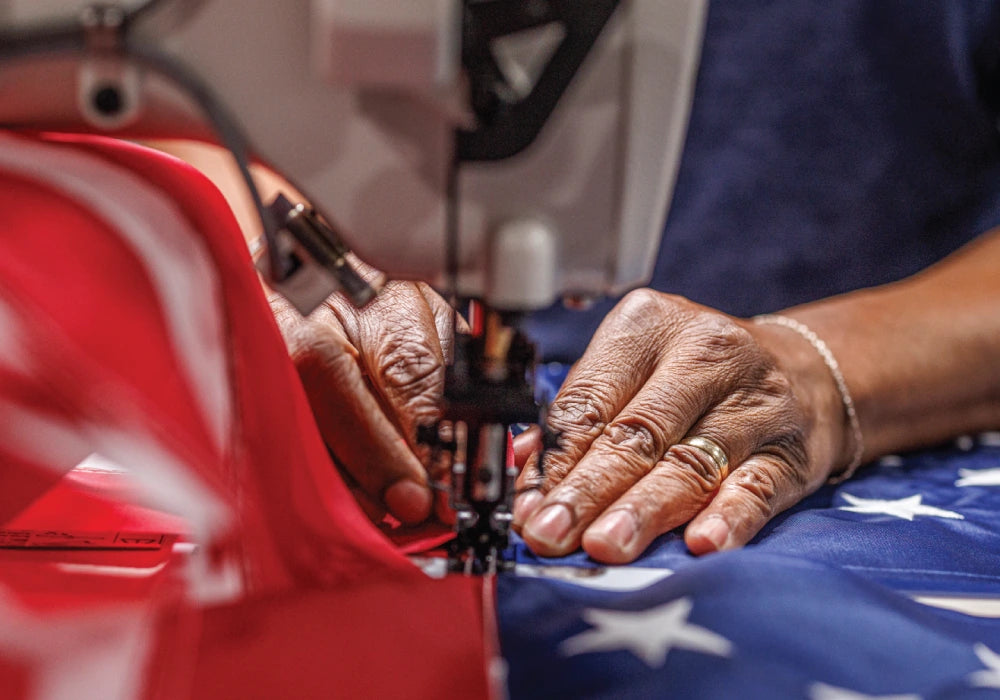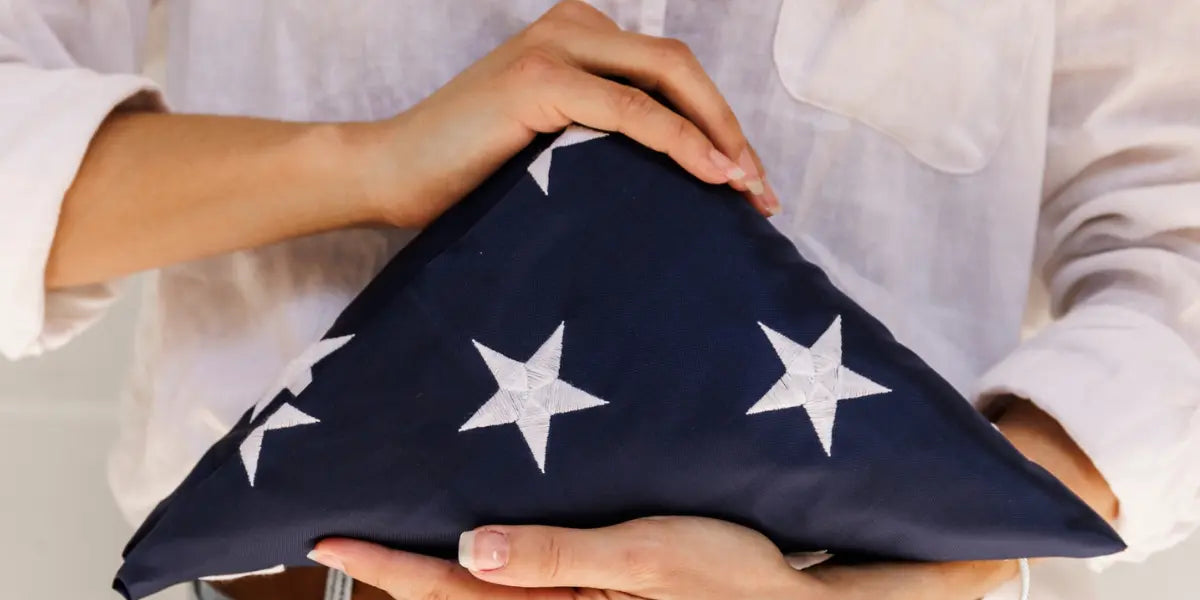Choosing the right size American flag is an important consideration for anyone looking to display the flag. Whether you are flying the flag at your home or business, or using it for a parade or event, the flag's size can greatly affect its visibility and overall appearance. In this article, we'll discuss the factors to consider when choosing the right flag size and provide guidance on making the best choice.
Factors to Consider When Choosing the Right Size Flag
When choosing the right flag size, several factors should be considered. The flagpole's size, the building's height, and the intended use of the flag are all important factors to consider. It's also important to keep the overall aesthetic of the setting and the flag's location in mind.
Flag Size Charts and Standard Dimensions
Charts and tables are invaluable tools for quickly comparing standard flag dimensions and their typical uses. These visual aids make it easy to match your display needs with recommended flag sizes, ensuring both proper etiquette and visual harmony:
-
Comprehensive Flagpole-to-Flag Size Tables: Charts typically list recommended flag sizes for various flagpole heights, such as 3’ x 5’ for a 20-foot pole or 5’ x 8’ for a 30-foot pole, allowing users to find the ideal match at a glance.
-
Application-Specific Sizing Guides: Many tables categorize flag sizes by application—such as residential, commercial, parade, or boat use—helping users select the correct dimensions for their intended setting or event.
-
Standard Dimension References: Charts often include the most common flag sizes (e.g., 3’ x 5’, 4’ x 6’, 5’ x 8’) alongside their metric equivalents, making it easier for users to convert and compare measurements as needed.
-
Visual Proportion Ratios: Some tables highlight the recommended flag-to-pole ratio, such as one-quarter or one-third the pole’s height, providing a visual reference to maintain proper proportions and flag etiquette.
-
Multiple Flag Display Charts: Specialized tables address scenarios where two or more flags are flown on a single pole, outlining maximum combined flag sizes to prevent overloading and ensure a balanced display.
-
Government and Military Specifications: Certain charts detail official flag dimensions required for government agencies, military bases, or ceremonial purposes, ensuring compliance with regulations and formal standards.
These visual resources simplify the decision-making process and promote respectful, visually appealing flag displays in every setting.
Building Height and Flag Size
The height of a building plays a significant role in determining the appropriate flag size because it directly affects how visible and proportionate the flag appears from both nearby and distant vantage points. A flag that is too small on a tall structure may appear insignificant or go unnoticed against the vast vertical expanse of the building, diminishing the visual impact and symbolic weight it is meant to convey. Conversely, a flag that is excessively large can dominate the structure and disrupt architectural balance. When selecting a flag for a high-rise or multi-story building, visibility from the ground, the surrounding skyline, and even aerial perspectives must be considered. Flags flown on rooftops or tall facades are often subject to stronger wind forces, so material durability and reinforced stitching are essential to prevent tearing. For buildings exceeding 150 feet, larger flags, ranging from 25 to 30 feet in length, are typically ideal for preserving proportional harmony and ensuring that the flag remains a recognizable emblem even from blocks away. Additionally, the environment surrounding the building influences the optimal dimensions. For instance, in downtown districts where tall buildings cluster tightly, a slightly larger flag can counter visual obstructions. Illuminated or spotlighted flags, particularly those displayed at night, also benefit from increased size since the added surface area allows light to accentuate movement and texture, creating a striking patriotic display.
As a general rule, the flag’s length should be about one-fifth the height of the building. This formula maintains aesthetic proportion and ensures that the flag complements rather than overwhelms its architectural setting. Thus, a 100-foot building should feature a flag approximately 20 feet long, while a 200-foot tower would look balanced with a 40-foot flag. However, adjustments can be made based on design intent. Government buildings, memorials, and civic centers often display flags larger than the standard ratio to emphasize national pride or historical significance. The mounting location also influences the choice: wall-mounted poles on mid-level floors may call for smaller flags to maintain proper drape and visibility, whereas rooftop masts permit larger, more commanding banners. In coastal or high-wind regions, lighter fabric and vented flag designs allow for appropriate size selection without compromising durability. The flag’s motion and drape quality also contribute to its perceived size; therefore, choosing the correct fabric weight and cut ensures visual dynamism even on calm days. For commercial properties, flag size can subtly communicate brand stature or institutional presence, especially when paired with architectural symmetry and professional-grade installations. Selecting the right flag size for a building is a balance of proportion, visibility, and context, achieved through thoughtful consideration of structure height and symbolic intent.
Materials and Quality Considerations
These factors not only affect the flag’s appearance and longevity but also ensure it withstands environmental conditions and maintains its symbolic dignity. Thoughtfully evaluating these aspects will help you choose a flag that remains vibrant, durable, and respectful for years to come.
-
Flag Material: The material of the flag is a primary determinant of its durability and suitability for different settings. Common options include nylon, polyester, and cotton. Nylon flags are lightweight, dry quickly, and fly well in gentle breezes, making them ideal for most climates. Polyester flags, particularly 2-ply varieties, offer superior strength and are best suited for high-wind or harsh outdoor environments. Cotton flags provide a traditional look but are more susceptible to fading and wear, especially outdoors.
-
Quality of Craftsmanship: The construction quality of a flag greatly influences its lifespan and appearance. Look for double-stitched or reinforced seams, which help prevent fraying in windy conditions. Heavy-duty headers and securely fastened grommets or reinforced pole sleeves add to the flag’s structural integrity. High-quality flags often come with guarantees or certifications from reputable manufacturers, signaling reliable materials and expert workmanship that stand up to regular use.
-
Finishes and Attachment Features: Consider the type of finish and attachment method when choosing your flag. Outdoor flags typically feature brass grommets set into a sturdy canvas header, providing secure mounting to flagpoles and resisting tears. Larger flags may use roped headings or thimbles for added strength. For indoor or ceremonial use, flags with pole sleeves and decorative fringe offer a polished appearance. Matching the finish to your display method ensures both ease of installation and longevity.
-
Colorfastness and Fade Resistance: The flag’s ability to retain its vibrant colors is crucial for maintaining a respectful and attractive display. High-quality flags are made with colorfast dyes that resist fading from sunlight and harsh weather. UV-resistant coatings and tightly woven fabrics further protect against discoloration. Investing in a flag with proven fade resistance ensures that your symbol of patriotism remains bright and dignified, even after extended outdoor exposure.
By carefully considering material, craftsmanship, finish, and colorfastness, you can select an American flag that not only looks impressive but also stands up to the demands of its environment. Prioritizing quality ensures your flag remains a proud, lasting symbol worthy of its place in your home, business, or community.
Intended Use of the Flag
The intended use of the flag is also an important consideration when choosing the right size. If you are using the flag for a parade or event, you may want to choose a smaller flag that is easy to carry and maneuver. If you are flying the flag outdoors, you may need a larger flag to ensure that it is visible from a distance. If you are flying the flag indoors, a smaller flag may be more appropriate.
Additional Display Factors
Other relevant factors that may influence flag size selection. One of the most significant is wind exposure. The environment where the flag will be flown can greatly affect both the optimal flag size and its longevity. In regions with frequent high winds, larger flags are subjected to greater stress, which can accelerate wear and tear. In such cases, it is wise to select a slightly smaller flag or opt for reinforced materials and stitching to withstand the elements. Some flag retailers and experts recommend referencing local wind speed charts to determine the maximum safe flag size for your location, ensuring both the flag and flagpole remain secure and intact during adverse weather. Choosing lighter-weight fabrics or vented flag designs can help reduce strain on the flagpole while still maintaining a visually impactful display. Another key consideration is the intent to fly multiple flags on a single pole. Many people wish to display the American flag alongside state, military, or organizational banners. However, flying more than one flag requires careful calculation to avoid overburdening the flagpole and to maintain an aesthetically balanced appearance. The combined square footage of all flags on a single pole should not exceed the maximum recommended for the pole’s height and strength. For example, if a flagpole is rated for a maximum flag size of 5’ x 8’, the total area of all flags flown at once should not surpass 40 square feet. Typically, the American flag is flown at the top and should be the largest or at least equal in size to other flags displayed below it. Proper sizing ensures that all flags are visible, flutter freely, and do not become entangled, while also preventing undue wear on the pole and hardware.
Finally, displaying flags without a traditional flagpole introduces its own set of sizing considerations. Flags intended for wall or window display may need to be smaller to fit available space, while still large enough to be recognizable and respectful. For indoor or ceremonial use, flag sizes are often dictated by the proportions of the room or the presence of other décor. In parades, handheld flags should be lightweight and manageable, typically ranging from miniature sizes for distribution to spectators, up to medium sizes that can be carried comfortably for extended periods. When draping flags over vehicles, caskets, or other objects, it’s important to follow official guidelines for size and placement to ensure proper respect and compliance with flag etiquette.
A National Symbol
The American flag is a symbol of America and our national identity. It represents the values and ideals of our country, including freedom, democracy, and justice. It is recognized around the world as a symbol of freedom and democracy. It is often displayed alongside other national flags at international events, such as the Olympics.
The design of the American flag is rich with symbolism. The 50 stars represent the 50 states of the union, while the 13 stripes represent the original 13 colonies. The colors of the flag are also significant, representing valor, purity, and justice. It also has a long history of use in American culture and society. It has been used in political campaigns, on military uniforms, and in patriotic displays at national events. The American flag is a powerful symbol of America and our national identity. It represents our values, history, and culture, and serves as a reminder of the sacrifices and accomplishments of those who have fought for our country.
Choosing the right size American flag is an important consideration for anyone looking to display the flag. By considering factors such as the height of the flagpole and building, as well as the intended use of the flag, you can ensure that you choose the right size to meet your needs. If you're not sure what size flag to choose, consider reaching out to an American flag store or U.S. flag store for guidance on the best options for your specific needs. Show your American pride with the perfect flag and visit Allegiance to find high-quality U.S. flags in every size. With the right flag and size, you can display the American flag with pride and respect.






